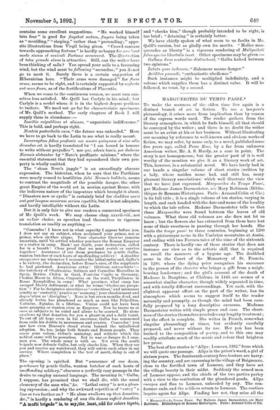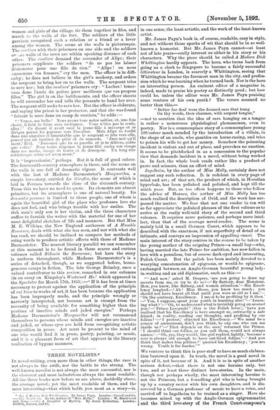MARGUERITES DU TEMPS PASSE.*
To make the manners of the olden time live again is a distinct branch of art in fiction. To use a lawyers's phraseology, it arises more from implication than by reason of the express words used. The reader gathers from the literary atmosphere, in which he finds himself, all that should be conveyed by the writer ; and there is no doubt the writer must be an artist at his or her business. Without illustrating our meaning by reference to well-known and obvious works of fiction, we may refer, by name only, to a novel, published some five years ago, called Passe Rose, by a far from unknown American writer, Mr. A. S. Hardy, as a case in point. The story is not homogeneous; but the greater part of it is well worthy of the mention we give it as a literary work of art. This, however, is a substantial novel. We have lately had in our hands a singular volume of short stories (written by a lady, whose maiden name had, and still has, many pleasant literary associations) which well illustrate the view that we have just expressed. _Marguerites du Temps Passé, par Madame James Darmesteter, née Mary Robinson (Biblio- theque de Romans Historiques. Paris : Armand Colin et Cie.) is its full title ; it is a single volume of ten stories, varying in length, and each beaded with the date and name of the locality to which the tale refers. Madame Darmesteter tells us that these Marguerites were found between the leaves of old volumes. What these old volumes are she does not let us know ; but the flowers she has extracted from them have lost none of their sweetness in passing through her hands. She limits the temps passe to three centuries, beginning at 1290 with a picturesque scene in the Umbrian mountains at Assisi, and ending with two Ferrara tales of the time of the sixteenth century. There is hardly one of these stories that does not instance our view as to the artistic skill that is required to recall the manners of a bygone age. The deathbed scene in the Court of the Monastery of St. Francis, in 1290, where the dying prior recognises his successor in the person of the chevrier who brings a gift from a neigh- bouring landowner; and the girl's account of the death of Madame la Dauphine, at Chiilons, in 1446, are scenes of a somewhat similar character, though widely separated in time, and with totally different surroundings. Yet each, with the slightest apparent effort on the part of the writer, has its atmosphere which seems to suggest itself to the reader naturally and promptly, as though the mind had been care- fully prepared by a long descriptive excursus. Madame Darmesteter writes with simple grace and ease. The short- ness of the stories themselves precludes any lengthy treatment ; but the effect is complete. She writes in French, somewhat singular phraseology at times, but evidently carefully prepared. and never without its use. Her pen has been trained to the composition of poetry, and to this one may readily attribute much of the music and colour that brighten her prose.
The best of her stories is "Alipz: Lumeau, 1382," from which we will quote one passage. Alipz is the priest's ward, a girl of sixteen years. The fourteenth-century free-booters are harry- ing the country, and are carousing in the village of Boigneanx, close to the fortified town of Lumeau, and they have set the village beauty in their midst. Suddenly the armed men of Lumeau appear, and the chiefs of the two parties parley with a view to the restitution of the plundered goods. Alipz escapes and flies to Lumeau, unheeded by any. The con- ference ends, and the soldiers return to Lumeau. The routiers inquire again for Alipz. Finding her not, they seize all the
• Marguerite, du Temps Passi. Par Madame James Darmesteter, /tie Mary Bgbiason, Bibliotheque de Romans Historiques. Paris Armand Velin et Cie. women and girls of the village, tie them together in files, and march to the walls of the fort. The soldiers of the little
garrison recognised each a relation or a friend or a lover among the women. The scene at the walls is picturesque. The roe tiers with their prisoners on one side and the soldiers or. .ne walls of the town are within speaking distance of each other. The routiers demand the surrender of Alipz ; their prisoners supplicate the soldiers "de ne pas les laisser desbonorer pour une fille de rien." " Alipz ! on nous emmenons vos femmes," cry the men. The officer is in diffi- culty; he does not believe in the girl's modesty, and orders the sergeant to bring her on to the walls. The sergeant tries to save her ; but the routiers' prisoners cry : " Laches ! tenez- vous done l'amie du pretre pour meilleure que vos propres filles." The girl is on the battlements, and the officer shouts he will surrender her and tells the peasants to band her over. The sergeant still seeks to save her. But the officer is obdurate, and saying the priest is her protector, and that sbe was found " faisant la note dans un camp de routiers," he adds :-
"' Vanes, ma belle'. Nous avons tous notre metier, et, une fois ehoisi, it taut le faire sans reehigner. Vous n'etes pas in seule, allez !' Ce disant it avait saisi la jeune fille a mi-corps et se dirigea parmi les paysans vers l'escalier. Mais Alipz se tordit dans une angoisse si lamentable que le sergeant se jeta vers elle, pouss6 par tua instinct de piti6 et de remords. Ture.moi qu'il
ment, Jure-moi que to es pucelle at je to &Byre, coAte qua coAte.' Pour toute response la jeune fille cacha son visage dans ses mains, image de honte et de desespoir. Un long rire soldatesque salua cet aveu muet."
It is " impressionist," perhaps. But it is full of good colour. The fourteenth-century atmosphere is there, and the scene on the walls is one full of dramatic vigour. It contrasts well with the last of Madame Darmesteter's Marguerites, a simple love-story, entitled La Girojlee, the scene of which is laid in Ferrara towards the close of the sixteenth century. From this we have no need to quote. Its elements are almost primitive, but its atmosphere is one of natural beauty. Its dramatis personae is limited to three people, one of whom is
again the beautiful girl of the place who professes love she does not feel, and who brings trouble with her smiles. The rich man's only son is her victim, and the three characters suffice to furnish the writer with the material for one of her most delightful sketches of life and manners. But that Miss M. E. Wilkins, the New England authoress of A Humble Romance, deals with what she has seen, and not with what she has read, we should be inclined to compare her methods of using words to produce artistic effects with those of Madame Darmesteter. The nearest literary parallel we can remember at this moment is to be found in those scarce and curious volumes called Sidonia the Sorceress ; but here the story is uniform throughout, while Madame Darmesteter's is a series of detached, though, as we suggested before, homo- geneous essays in fiction. The late George Brimley, once a valued contributor to this review, remarked in our columns (in an essay on Kingsley's Westward Ho ! which appeared in the Spectator for March 17th, 1855) :—" If it has been at times necessary to protest against the application of the principle of cuibono to works of art, it has been because the application has been improperly made, and the principle wrongly or narrowly interpreted, not because art is exempt from the necessity of being available for something higher than the pastime of inactive minds and jaded energies." Perhaps Madame Darmesteter's Marguerites will not recommend themselves to persons whose minds and energies are inactive and jaded, or whose eyes are held from recognising artistic composition in prose. Art must be present to the mind of one who would find it in prose, poetry, painting, or music, and it is a pleasant form of art that appears in the literary realisation of bygone manners.























































 Previous page
Previous page